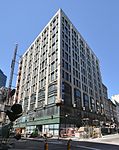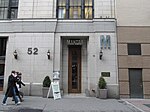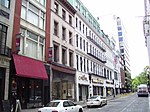Amory Hall (Boston)
Amory Hall (c. 1834 – c. 1888) was located on the corner of Washington Street and West Street in Boston, Massachusetts, in the 19th century. Myriad activities took place in the rental hall, including sermons; lectures by Henry David Thoreau, Ralph Waldo Emerson, William Lloyd Garrison; political meetings; exhibitions by Rembrandt Peale, George Catlin, John Banvard; moving panoramas; magic shows; concerts; and curiosities such as the "Nova Scotia Giant Boy." Through the years, tenants included: First Free Congregational Church (c. 1836); Grace Church (1836); artists Eastman Johnson, J.C. King, N. Southworth, T.T. Spear, William S. Tiffany (c.1847); Oliver Stearns, retailer of artists' supplies (1849–1850); artists J.A. Codman, A. Ransom, and R.M. Staigg (c.1852).In 1888, the hall was acquired by retailer William H. Zinn and incorporated into his "Connected Stores" occupying the block bounded by West and Washington Streets and Temple Place.
Excerpt from the Wikipedia article Amory Hall (Boston) (License: CC BY-SA 3.0, Authors).Amory Hall (Boston)
Washington Street, Boston Downtown Boston
Geographical coordinates (GPS) Address Phone number Website Nearby Places Show on map
Geographical coordinates (GPS)
| Latitude | Longitude |
|---|---|
| N 42.3546 ° | E -71.0617 ° |
Address
The Godfrey Hotel Boston
Washington Street 505
02111 Boston, Downtown Boston
Massachusetts, United States
Open on Google Maps









